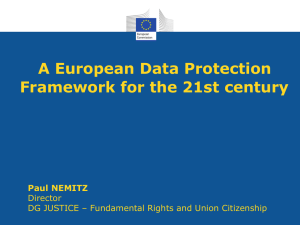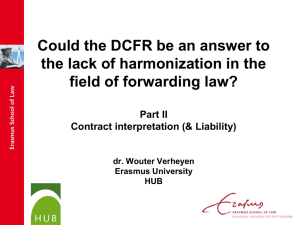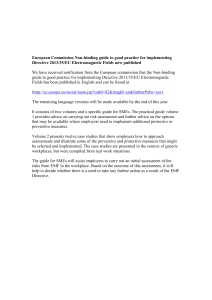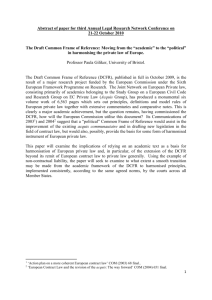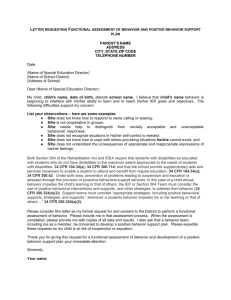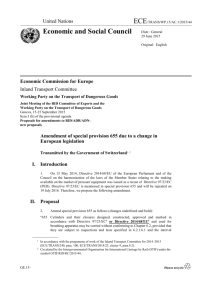The DCFR and the work of the Expert Group on a CFR
advertisement
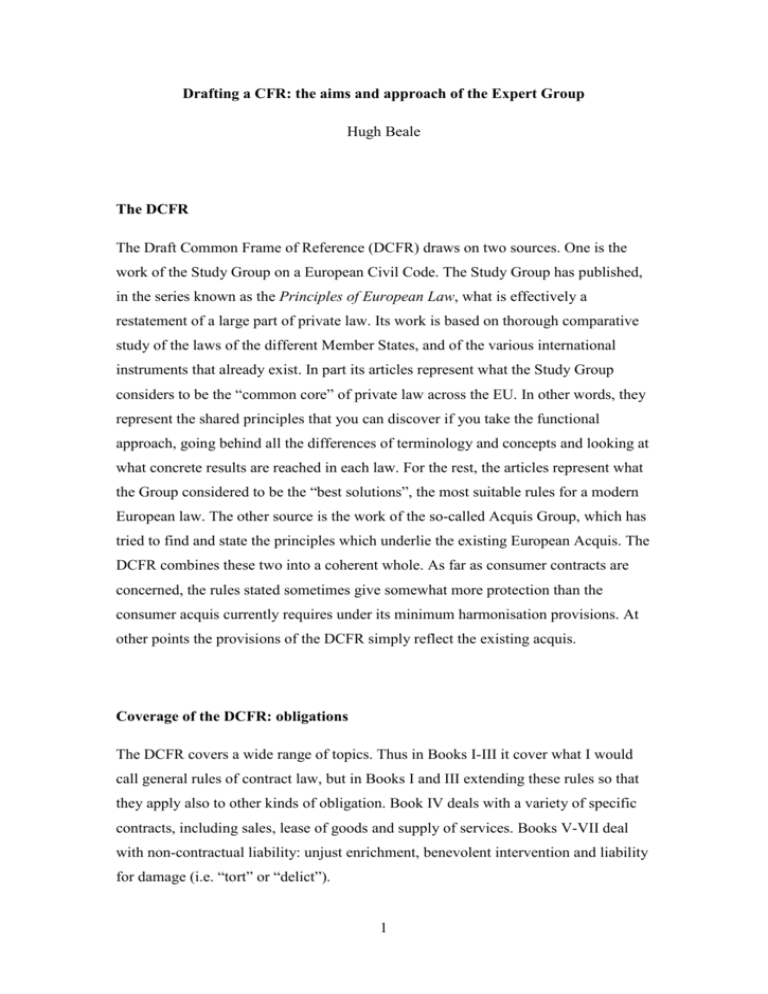
Drafting a CFR: the aims and approach of the Expert Group Hugh Beale The DCFR The Draft Common Frame of Reference (DCFR) draws on two sources. One is the work of the Study Group on a European Civil Code. The Study Group has published, in the series known as the Principles of European Law, what is effectively a restatement of a large part of private law. Its work is based on thorough comparative study of the laws of the different Member States, and of the various international instruments that already exist. In part its articles represent what the Study Group considers to be the “common core” of private law across the EU. In other words, they represent the shared principles that you can discover if you take the functional approach, going behind all the differences of terminology and concepts and looking at what concrete results are reached in each law. For the rest, the articles represent what the Group considered to be the “best solutions”, the most suitable rules for a modern European law. The other source is the work of the so-called Acquis Group, which has tried to find and state the principles which underlie the existing European Acquis. The DCFR combines these two into a coherent whole. As far as consumer contracts are concerned, the rules stated sometimes give somewhat more protection than the consumer acquis currently requires under its minimum harmonisation provisions. At other points the provisions of the DCFR simply reflect the existing acquis. Coverage of the DCFR: obligations The DCFR covers a wide range of topics. Thus in Books I-III it cover what I would call general rules of contract law, but in Books I and III extending these rules so that they apply also to other kinds of obligation. Book IV deals with a variety of specific contracts, including sales, lease of goods and supply of services. Books V-VII deal with non-contractual liability: unjust enrichment, benevolent intervention and liability for damage (i.e. “tort” or “delict”). 1 Coverage of the DCFR: property The remaining books cover proprietary issues: acquisition and loss of ownership in goods, proprietary security over moveables and trusts. The “Academic” CFR The DCFR was produced for the European Commission, which in its Action Plan for a European Contract Law called for a Common Frame of Reference that might fulfil two distinct purposes. The first was to act as a legislator’s guide or tool-box, setting out “fundamental principles, definitions and model rules”. These would be used immediately to assist in a revision of eight consumer directives, and later might be used for the drafting of any further EU legislation on contract. The second was to provide the basis of a possible Optional Instrument on contract law. The idea was to overcome the barriers to cross-border trade, or at least to reduce the costs of crossborder-trade, caused by differences between the laws of contract in the various Member States (MS), by providing a system of contract rules that could be used in place of any of the national laws. It might be used for contracts between businesses (B2B) and/or contracts between a business and a consumer (B2C). Now it soon became obvious that the DCFR contained far more than might be needed for these purposes. To function as a toolbox, the CFR would really only need to provide model rules on topics that are likely to be the subject of further Directives on contract law, and to provide definitions of concepts to which Directives are likely to refer. In fact that might include a considerable number of topics: for example, Directives quite frequently refer to, or assume that MS will have, rules of unjust enrichment (e.g. to govern the consequences of a consumer’s withdrawal from a contract) or tort law (e.g. they assume that MS have laws imposing liability for fraud). A CFR that was only to form the basis of an optional instrument would probably be even narrower, since it seems very unlikely that the EU would adopt an Optional Instrument covering more than certain common types of contract. So during the conferences and stakeholders’ meetings that took place while the DCFR was being 2 drawn up, it became common to refer to the DCFR as an “academic draft” and to accept that ultimately the “political CFR” would be narrower in coverage. Consumer Rights Directive Meanwhile, however, the plan was affected by politics. The Commissioner responsible decided that he could not wait for the DCFR to be completed before starting to improve the consumer directives. So work on the consumer acquis was given priority. The result was the proposed Consumer Rights Directive (pCRD) of October 2008. This drew on some ideas presented by “the researchers” to stakeholder meetings, but did not even attempt to draw on the drafts of the DCFR that were by then available to provide detailed model rules or definitions. The pCRD sought to revise only four Directives: The main thrust was to combine these into a single so-called horizontal directive which would treat the subject-matter more consistently – though as the selected Directives were those on distance selling, doorstep selling, consumer sales and unfair terms, the result is not horizontal in the sense of all the articles applying to all kinds of consumer contracts. At the same time the pCRD made a limited number of changes to strengthen consumer protection – for example, a consumer supplied with non-conforming goods would have a right to damages rather than just a right to a price reduction or to rescission if the goods have not been repaired or replaced by the seller. Full harmonisation The most striking innovation of the pCRD, however, was that it was to be a full harmonisation Directive. The Commission’s view is that one reason that there is only limited cross-border selling to consumers is that legal differences are a barrier. Under article 6 of the Rome I Regulation, a consumer who contracts with a business in another MS after being subjected to advertising by the business is entitled to the protection of the consumer protection rules of his country of residence. This means that a business advertising its goods across Europe, for instance via a website “e- 3 shop”, must be prepared to deal with the consumer protection rules of at least 28 different jurisdiction (28 because Scotland has a separate legal system from that of the rest of the UK). Full harmonisation sought to solve this problem by preventing MS from giving their consumers any more rights than the Directive required - so that within the scope of the Directive, the law of all MS would be the same at least in substance. I think even the Commission now acknowledges that this full harmonisation idea is a failure. One reason is that it would inevitably lead to a reduction of protection in MS that currently provide a higher level of consumer protection than would be required by the pCRD. This would be unacceptable to many MS, let alone to their consumer associations. Another reason is that there would be uniformity only on those topics that would be covered by the pCRD. Either large areas of contract law would be left unharmonised, or it would mean that the CRD would have to widened to cover far more topics – something few MS would agree to. In other words, as a tool of encouraging cross-border selling, full harmonisation simply would not do what had been hoped. So instead the Commission is now thinking of targeting full harmonisation at narrow topics such as the length of withdrawal periods. To solve the problems of the Internal market, it is looking to the Optional Instrument. The argument is that if businesses can sell to consumers right across Europe on the basis of a single legal system, their costs will be lower. This will encourage cross-border selling, and so bring consumers the benefits of greater choice, increased competition and possibly improved quality. The Green Paper However, the Commission has not yet decided that an Optional Instrument is the way forward. In July 2010 it published a Green Paper setting out various options. These range from doing nothing, through creating a CFR toolbox in various forms, a Recommendation to MS on contract law, or an Optional Instrument to, at the extreme, a harmonising Directive on European contract law and even a full-blown European Civil Code. I do not believe that all the options are serious candidates – my own government would never agree, for example, to full harmonisation of contract law, let 4 alone a European Civil Code. The front runners seem to be the CFR as a tool box and the Optional Instrument – which could both be created. The Expert Group Meanwhile in one of those topsy-turvy moves so typical of at least European Union politics, the Commission had already decided in April 2010 to establish a group of experts who would be charged to turn the DCFR – or some of it – into a CFR. As the Commission did not know what the CFR would be, the group was asked to draft on an “as if” basis – which some of us took to mean that we should try to draw up a document that could form either a toolbox or an Optional Instrument. But last month, following the arrival of a new Director-General and a new Head of Unit, the brief was narrowed. We are not to worry about a toolbox. What we are asked to do is to draft a workable optional instrument that would apply to B2B and/or B2C cross-border contracts. Initially it should apply only to cross-border sales, though the general part should be drafted in terms that it can be applied to other kinds of contract if in the future it is decided to expand the scope of the OI to cover other types of contracts, for example for the supply of services. The OI and Private International Law What would a “workable” OI entail? An obvious question is how this would fit with private international law and in particular with the Rome I regulation. This is a matter that the Commission itself will be responsible for, and no decision has yet been made. However, they have explained their current thinking. This is that they will not seek a private international law solution but one of “substantive law.” In other words, they envisage a regulation which would create in the law of every member state a separate set of contract rules which would apply to cross-border sales of the relevant type, if the parties opted for it. In other words, it would operate in the same way as does the Vienna Convention in International Sales of Goods (CISG), save that it would be an opt-in regime - and it would be provided that if the parties to a B2B sale opted for the OI, that would constitute an option out of the CISG. The OI would displace the 5 national law that would otherwise apply, including its mandatory rules - but the OI would contain its own mandatory rules. This approach would mean that article 6 of the Rome I regulation would never come into play. The OI might also provide that courts could not treat the consumer protection rules of domestic law as internationally mandatory rules to be applied under art 9 despite the choice of law. B2C sales How would this scheme work for B2C sales? The OI would contain not only special rules on consumer sales, but also the general parts of sales law and general contract law, since much of this applies also to consumer sales. In terms of consumer protection, the OI would of course have to offer at least as much consumer protection as is required by the consumer acquis - the proposed Consumer Rights Directive and also the Consumer Credit Directive of 2008, since sales under which the buyer pays by instalments fall within the latter. It would also need to copy more-or-less word-forword those parts of the directives that require full harmonisation. A “high level of consumer protection” The Expert Group and the Commission both seem to take the view that it would not suffice if the OI only required the level of consumer protection that is required by EU legislation. In MS where consumers have only the minimum protection required by EU law, choosing the OI, e.g. for an on-line purchase by clicking on a “Blue Button”, would not reduce the consumer’s rights. However, in the many MS where the level of protection is higher, it would result in a reduction of protection. In theory, of course, the consumer may decline to push the Blue Button; he or she may thereby try to protect his or her rights under local law, as a result of article 6 of the Rome I Regulation. But in practice, it seems unlikely that the business will offer that choice. At least those businesses which at the moment are discouraged from selling across borders because of uncertainty about the applicable law seem unlikely to offer a choice: with them it will be the Blue Button or nothing. So to make the OI sufficiently attractive to be viable, it will need to contain a higher level of consumer protection 6 that is required by the EU. On the other hand, it will not contain every possible consumer protection device, because then no business would ever agree to it. A “consumer sub-group” of the Expert Group To try to work out what to do, the Expert Group has decided to set up a consumer law sub-group. This will firstly work out where the DCFR already provides more protection than EU law requires. Then the sub-group will ask what provisions beyond the EU requirements are found in the laws of MS. These protections may be ones that are within the scope of the consumer acquis, for example where standard terms are black-listed. They may also be protections which are not addressed at all by the consumer acquis, for example rules on lesion, which are found still in the laws of some MS, and general controls like those of the Nordic Contracts Act, s 36. Then as assessment will need to be made of which rules to include in the OI if, in the view of the Expert Group, it is to contain a sufficiently high level of consumer protection. B2B: who might use it? How would the OI work for B2B contracts? The first question is, who might use it? In principle, any business might benefit from being able to use a single, neutral law available in many languages, for all its contracts across Europe – the OI might operate like a single “operating system” or “platform” for European business. But in practice I suspect that the OI may not be of great interest to large firms. There are a number of reasons. First, they often operate through subsidiaries in the different countries rather than selling cross-border as such. Secondly, they often have enough expertise to deal with foreign law – or, if they do not, their contracts are sufficiently large and valuable that the cost of taking legal advice becomes proportionately minor. Moreover, many of them are involved with risky transactions where it is important to know exactly what the law is. I think - and here I am expressing only my own view, though I believe it is widely shared in the Expert Group and possibly in the Commission – that it is SMEs at which the OI should be targeted. 7 What do SMEs want? I suspect that SMEs are generally risk averse. They would probably like to know that if they make a mistake – if, for example, they make a contract without knowing some critical fact; or if they are caught out by a harsh clause in the other party’s standard conditions of contract; or if the other party behaves badly in some way that the SME had not expected – in these situations, I think that SMEs would welcome the court having some power to protect them, by giving relief for mistake or making the other party liable for non-disclosure, by striking down the harsh term, etc. Now we might achieve protection for SMEs by an EU “Small Business Contracts” Directive, requiring MSs to provide the necessary rules. But then we would have great difficulty in defining which business and contracts it should apply to. It seems better to let the businesses that want protection to self-select, to choose protection by seeking to get their contracts on the terms of an OI which contains the necessary rules. An OI for SMEs So I hope to see an OI that covers B2B contracts – sales contracts first, then later to be extended to, for example, other contracts for the supply of goods and to contracts for the supply of services. And, as I say, it should be targeted at SMEs, for them to use when they are dealing with either another SME or a larger business. It would give them a kind of insurance. It might cost a bit more: if one party bears less risk, then the other necessarily bears more and might want an adjustment in price. But it is my hunch that the SME will often be prepared to pay the premium. Why would the other party agree? Why would the other party, especially if the other party is a larger business, ever agree? The answer is that if the SME is prepared to pay a premium that covers the extra, the larger business will find it worth offering to contract on the OI. If the lager business refuses, at least the SME will know that they are about to make a riskier contract and perhaps they should take advice. And if the OI is simply unsuitable for 8 the kind of business- even SMEs sometimes are involved in speculative, high risk transactions - they simply will not choose it. An OI for domestic use? What we all wonder is whether the OI needs to be reserved for cross-border contracts. If businesses would prefer to use the OI even for domestic contracts, whether B2B or B2C, why prevent them? But that is really a question for national legislators, not for the EU or the Expert group. The OI compared to the DCFR In terms of the subjects it covers, the OI will be much narrower than the DCFR. The draft that the Expert Group has been asked to produce will cover only the general part of contract law and sales. It will not cover non-contractual obligations except as these impinge directly on contracts. Thus, like the Principles of European Contract Law (PECL), it will cover liability for fraud and for incorrect information even though in many systems these would both be classed as non-contractual. It is yet to be decided whether it will cover any aspects of restitution; if it does, it will almost certainly do so by having a few sections dealing with the effects of avoidance or of termination – again like the PECL. Thus what was Book III of the DCFR will deal only with obligations related to contract, and to that extent the OI will be “re-contractualised”. The Expert Group has also been asked to make the draft as clear and “user-friendly” as possible. Thus we will be going through the texts looking for any possible simplifications. Much of this work has yet to be done, but it is possible that we will end up with a draft that is closer in style to PECL, which aimed to be understandable to the businessperson, than to the DCFR. I wish I could say that the OI will resemble PECL closely in all respects. Unfortunately that seems unlikely to be the case, for one simple reason. The Commissioner who is driving the project forward, Mrs Reding, said at one point that what is required is an OI of about 150 articles. Unfortunately, this figure seems to be 9 taken by the Commission not as just an indication that the OI should be short compared to the DCFR but as a fixed limit. Nor are we allowed to cheat by simply combining articles. Where this figure of 150 came from I do not know, but it is quite unrealistic and we are doing our very best to persuade the Commission to remove the limit. If the limit stays, it will be very difficult to produce an OI that covers even the principal issues of general contract law. Agency and most of the contents of PECL Book III - assignment and transfer of contracts, conditional contracts, plurality of parties, prescription and set-off would all have to be omitted. That might not be fatal – it would be possible to add such discrete topics later. However, there would also have to be a very severe pruning of the remainder. We have yet to work out whether this can be done without weakening the whole fatally. A dialogue I believe that all the members of the Expert Group feel this to be the most serious single problem with the project. What I hope is that others will support us. We are not working on our own. In fact there is a five-way dialogue, between us, the Commission’s CFR Team, the separate team in JLS working on the CRD, the Parliament (MEPs like Mr Klaus-Heiner Lehne and Ms Diana Wallis have been showing keen interest in our work and have come to meetings) and the “sounding board” of stakeholders established by the Commission. Perhaps even the Council will join in the discussions. Summary and conclusion In summary: the Expert Group is being asked to produce a short OI which is to cover cross-border sales, though in a form which could later be extended to other contracts such as for the supply of goods or services. It should apply to both B2B and B2C contracts. For B2C contracts it must provide a high level if consumer protection. For B2B contracts, it will probably be targeted at SMEs. Where this can be done within a size limit acceptable to the Commission, and in the very short time available, remains to be seen. 10 I believe that if we can create such an OI, I believe it would be very useful. However, it is only one of the steps that we should take. First, I still want to see improvements in the consumer directives, including very limited full harmonisation. We would need these harmonising measures to deal with consumer contracts that will remain outside the scope of the OI. And I also want to see the “toolbox” CFR, to provide definitions of the many legal concepts that are used in European law without being defined, but which nonetheless are to be given an autonomous European legal meaning. 11
